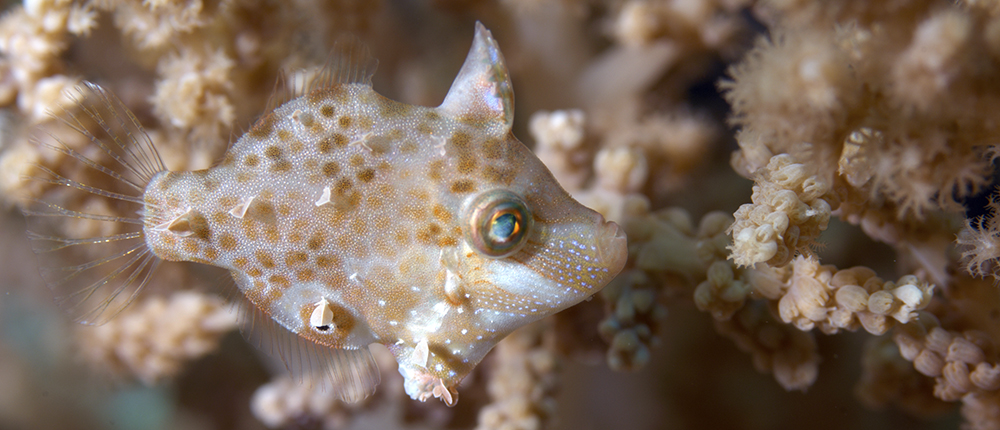Born on the Reef
Coral reefs are often described as the nurseries of the sea. Which means that when you are enjoying one of Wakatobi’s signature dive sites, you are immersed in an undersea maternity ward. The process of reproduction is ongoing, and it’s taking place all around you. There are many fascinating ways the marine life of Wakatobi creates the next generation. You just need to know where to look, and what you are looking for.

In most species, the larger and more mature the lady, the bigger the size and quantity of the eggs produced. Here, the female spinecheek anemonefish is on the left. Photo by Walt Stearns
The dating game
The first step to successful reproduction is finding a suitable mate. Usually, it’s the male who makes the effort to attract and impress the female (sound familiar?) Fecundity is what makes a female attractive. In most species, the egg-carrying capacity is directly related to the size of the female and her size to her age: the bigger the female, the better capacity she has to produce bigger and better eggs, which in turn will produce bigger larvae, more suitable for survival. And so, the males have an instinctive tendency to go after larger and older females.

Distinguishing the males and females in this cluster of pyramid butterflyfish all comes down to body language. Photo by Walt Stearns
Once a male has identified his preferred female, he may stage an elaborate courtship display that includes fin flashing, dancing movements, brilliant patterns, and color changing. He’ll keep trying until he attracts his chosen lady into his territory. Coral reef fish are amongst the most elaborately ornamented animals on the planet. Their decorations are not just for show and actually play a fundamental role in reproduction, as distinct colors and unique markings help identify mates of their own species. But sometimes flashy paint jobs aren’t enough. Butterflyfish and wrasses, for example, are so numerous and have so many similar colors and patterns that in order to identify potential mates, some species have evolved specific body posture or unique movements.
Dance moves
Mating displays can be fascinating to watch, and one of the more poetic courtship displays in the sea takes place at Magic Pier, a site exclusively visited by the dive yacht Pelagian.

Competition can be stiff for the male mandarinfish as the supply of receptive females typically exceeds the number of enthusiastic males. Photo by Walt Stearns
As the sun sets, brilliantly-patterned mandarinfish gather in the shallows. The number of willing males usually exceeds the supply of receptive females, so competition can be stiff. Like aquatic peacocks, the males strut their stuff by erecting their forward dorsal fin and flashing bright colors as they perform a circling dance for attention. The ladies typically go for the larger, flashier males, and once they select their suitor, the male and female will align head-to-tail, raising their dorsal fins and begin a spiraling dance-like sequence of rotations that carries them above the reef. At the culmination of their spiral, they release eggs and sperm into the water column in the consummation of the pairing.
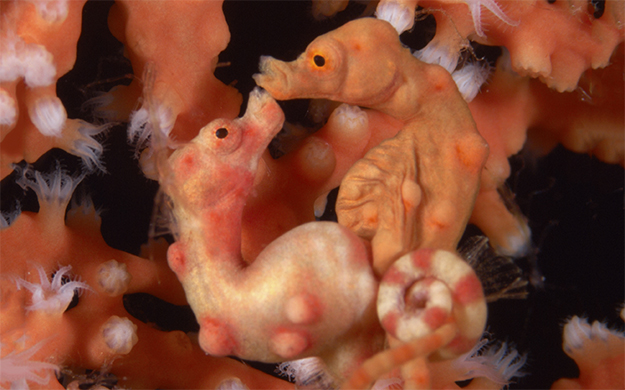
In the final phase of courtship, the lovers will assume a face-to-face position and begin a slow rise from the seafloor. Some species such as this Denise’s pygmy seahorse will also link tails during this ritual. Photo by Dr. Richard Smith
Seahorses stage equally intriguing and even more intricate preludes to mating. When a pair feels the urge to merge, they often begin with a pre-dawn pairing that involves a series of slow, synchronous swaying motions. This dance may go on for eight hours or more, during which time the male, who will be carrying the youngsters to term, extends his egg pouch to show that it is indeed empty, and he is ready for parenting. This dance sometimes continues for a second full day, and as they move towards consummation, the pair may begin a series of color changes, quivering motions, and head postures that signal their readiness. In the final phase of courtship, the lovers will assume a face-to-face position and begin a slow rise from the seafloor. Some species also link tails during this ritual.
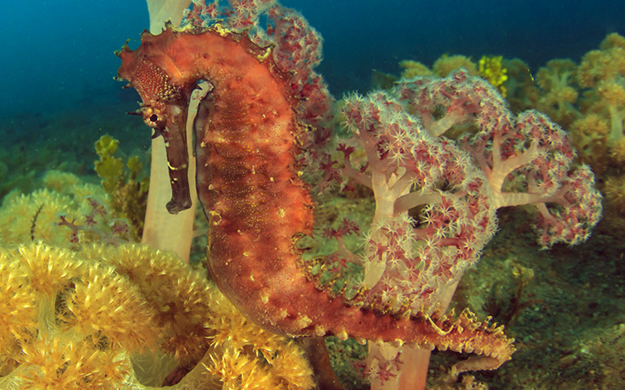
Once the female seahorse transfers her eggs into the male’s brood pouch she says goodbye, leaving dad in a family way. Photo by Rich Carey
After four or five simultaneous ascents and returns to the seafloor, the female will extend her ovipositor, which is a penis-equivalent protrusion she uses to transfers her pear-shaped eggs into the male’s brood pouch. Voyeuristic divers lucky enough to witness this act can actually see the female’s body grow slimmer while the male’s brood pouch swells with new life. The mother then says goodbye, leaving dad in a family way.
Cast out to sea
A limited number of marine animals such as some sharks and rays produce young that are fully formed and ready to live independently. But for most marine creatures, parenting means laying eggs. These oviparous breeders fall into three categories: pelagic spawners, egg layers, and brooders. The pelagic spawners are the most common, including not only most blue-water fish but also reef dwellers such as parrotfish and all manner of invertebrates such as crinoids. Species with limited mobility will typically release their gametes (eggs & sperm) into the water column at times of strong outgoing currents. This way, the eggs are sent seawards, where there is less chance of predation than on the reef.

At the culmination of their spiral dance, which takes place at dusk, mandarinfish will release eggs and sperm into the water column seen here at the female’s tail fin. Photo by Walt Stearns
Often the spawning happens at dusk when there is poor light, once again to reduce predation. Some reef dwellers spawn daily, others monthly and others yearly at a very specific time. To give their eggs a better chance of survival, some fish stage aggregations and produce gametes in large numbers. These impressive aggregations are known as mass spawnings. Most pelagic eggs and larvae are adapted to life in the open sea, with survival features such as flotation devices, body transparency, and a tendency to move towards the light, all of which serve to keep them closer to the surface and away from predators. When the eggs hatch, the creatures that emerge often have no eyes, no pigments, and no fins. These features will develop during the larval stage as they metamorphose into juveniles and begin to look like fish.
Brooding parents
The egg layers attach their eggs to the substrate. Sometimes the eggs are guarded by the parents up until the day of hatching. It is common to see some anemonefish, damselfish or gobies zealously guarding their eggs.
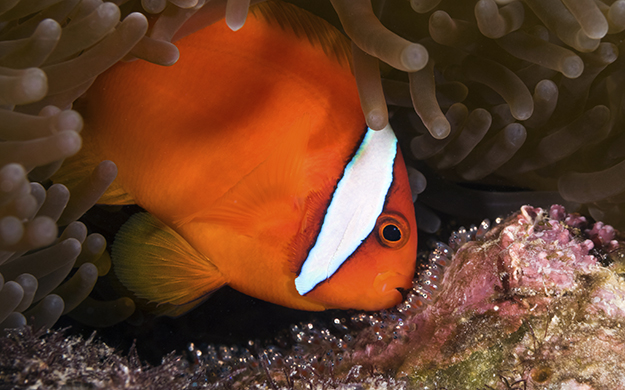
Egg layers such as this clownfish will attach their eggs to the substrate, zealously guarding them until the day of hatching. Photo by Walt Stearns
However, parental care is more an exception than a general rule on the coral reef, and species of egg-laying fish and shellfish, known as brood hiders, will simply bury their eggs or stash them in a natural hiding place on the reef such as a cavern or crevice, then leave the youngsters to fend for themselves once they hatch. Nudibranchs don’t stick around for parenthood, but they also don’t just abandon their young to the first egg-eater that passes by. For a bit of added insurance, their eggs often contain bitter toxins that serve as a powerful deterrent to predation.
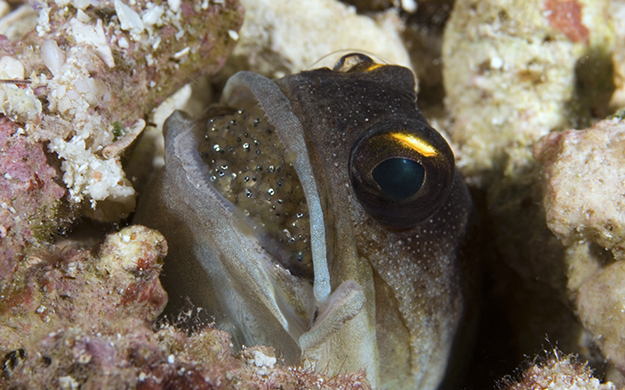
Some of the most impressive parents on the reef are the mouthbrooders, like this jawfish, which carefully carries the fertilized eggs in his mouth right up until hatching. Photo by Rob Darmanin
The brooders are the best parents on the reef, as they provide ongoing protection for their fertilized eggs as they develop. Male seahorse and pipefish carry their eggs in their pouch until hatching. Even more impressive are the mouthbrooders such as some cardinalfish and jawfish, with the male carrying and carefully caring for the delicate fertilized eggs in his mouth right up until hatching.
Alternate birth plans
Corals are amongst the most prolific animals on the face of the earth. Yet, when you take into consideration that the life of a coral polyp means that its behind is glued to a rock and surrounded by nothing but relatives, well, finding a date is next to impossible. Hence, they have evolved an arsenal of reproductive strategies that allow them to reproduce and survive in good times and in bad.
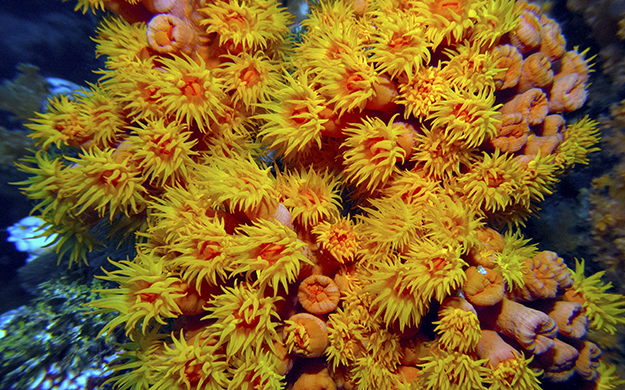
This brilliant spray of orange and yellow tube corals began as a single polyp and self-cloned to eventually turn into the colony you see here. Photo by Terry Crocker
Some corals are Gonochoristic, meaning they have separate male and female organs. Some are simultaneous hermaphrodites, meaning they can self-fertilize and produce gamete bundles of eggs and sperm. And asexual reproduction in corals can take the forms of self-cloning or fragmentation. Self-cloning is when a new polyp is formed when a mature polyp splits in two, drops a small branch, or sprouts a new mouth that develops into a peripheral polyp. Fragmentation occurs when stony corals are broken and scattered, with new colonies developing and sprouting up where the pieces land. During sexual reproduction, they broadcast spawn their eggs and sperm. Huge numbers of gametes are released into the water column to develop in the plankton. The coral larvae may drift for months before finding and settling upon a suitable patch of substrate.
These are just some of the unique and fascinating ways the marine life of Wakatobi creates the next generation. Ready to witness this underwater genesis for yourself? It’s as easy as planning a trip to Wakatobi Resort, or a cruise on our dive yacht Pelagian. Complete a quick trip inquiry at wakatobi.com or e-mail our team at office@wakatobi.com.
Visit us on Facebook.


